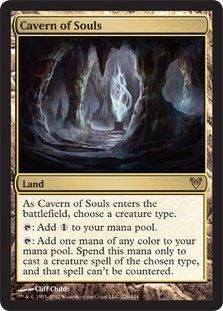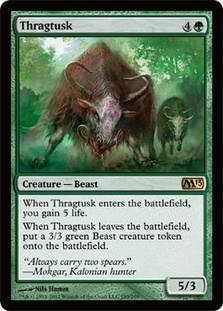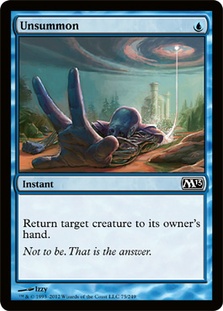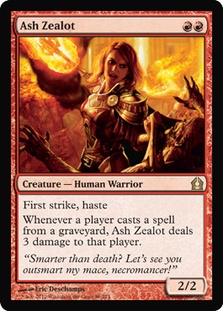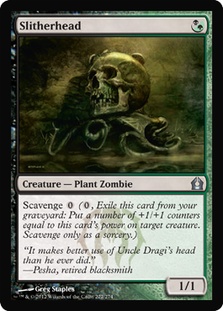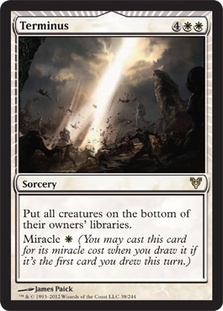Greetings and welcome back! This past week has been pretty Magic-filled for me, having gotten to play in four tournaments in the past seven days! In today’s article, I am going to share the decks that I have gotten to play with, give some results and suggestions on those lists, and share some of my experiences with you guys. It is always fun to spend a week going back to back to back to back with tournaments—it really gives a player a chance to learn a lot, simply by getting to play a bunch. So, hopefully some of what I have learned will be helpful to some of you guys out there.
At the very least, there are four decklists in here!
Thursday — Standard — Bant Control
Last Thursday I got a chance to battle Standard at Warriors III in Michigan. My weapon of choice was none other than a revised version of the Bant Control deck that I wrote about for last week. I really like this deck a lot and would almost certainly sleeve it up for any big Standard tournament I were to attend in the near future. I think it would be a particularly strong choice for one of the upcoming SCG Opens.
Creatures (13)
Planeswalkers (1)
Lands (25)
Spells (21)

As you can see, the deck is still very similar to what I had written about the week before. The major changes are that I went ahead and cut the Alchemist’s Refuge for a third copy of Cavern of Souls in the maindeck and also swapped a Forest for a Plains.
“Just ‘cave in’ and play it maindeck.”
Cavern of Souls had been testing so well for me, especially against popular decks like Esper and R/W/U Midrange, that I also decided to put the forth copy of this powerful land into the sideboard. One thing I have certainly noticed is that Thragtusk is the defining card of this current iteration of Standard—and, if the way that people are trying to beat the card is to counter it, then uncounterable Thragtusk is clearly on the higher plane of playing.
“The only drawback is it’s susceptible to permission (unless they have Cavern, in which case it is actually just unbeatable…).
I can certainly say that I won a very tough fought match against one of the better current Michigan players, Kenta Hiroki, by being able to produce uncounterable Thragtusks to help grind me back into a game where he had landed and was attacking with a Geist of Saint Traft on turn four with his R/W/U Midrange deck.
At the tournament I played against G/W Aggro, U/R Delver, R/W/U Midrange, Jund, and B/R Zombies and went undefeated in the Swiss. The top eight decided to split, so I didn’t get to play on any further—thought I certainly wanted to.
I am starting to feel really confident playing this deck, and I really like its flexibility.
“If Vapor Snag was format defining, why are more people not playing Unsummon?”
Unsummon has been a pretty nifty innovation and has swung the G/W matchup from a rough one to the auto-win category. Also, being able to side into a deck with Geist and Unsummon can catch a lot of control decks by surprise and provides a fair share of free wins.
Saturday — Modern — BUG Midrange
On Saturday I headed out with my girlfriend to the Windy City (aptly named) to try my hand at Modern. For this event, I was between Jund and BUG—basically because I felt that Deathrite Shaman was the best card in the format, and I really wanted to be playing with it.
“This thing has about as many applications as Cryptic Command!”
Jund and BUG are very similar decks; in fact they’re almost the same deck except one has red cards and one has blue cards, with all of the black and green cards largely staying the same. I felt that while Jund had the edge in combat-based matchups, BUG didn’t lose a ton of ground and made up a lot of space with regard to its combo matchups.
I started with the BUG deck that made Top 8 at the last Grand Prix and made some changes that I felt would make the deck better and more consistent. Here is what I sleeved. It was criminal the Top 8 list didn’t have a basic Swamp, which was one of the lands I enjoyed most having in play all tournament long.
Creatures (18)
Planeswalkers (2)
Lands (22)
Spells (18)

Basically, this is just a Jund deck that has to make a few sacrifices in order to play with counterspells. The drawback is that you lose Lightning Bolt, Terminate, and Bloodbraid Elf for weaker variants of the same cards: Disfigure, Doom Blade, and Snapcaster Mage. The upside is that you get to play with Mana Leak for combo decks, and you also get a better mana base that can play eight fetchlands because it is an enemy shard!
Isn’t it weird that the enemy shards have better mana bases because there are only off-color fetchlands? C’mon, Wizards; this is stupid. Polluted Delta in M2014 PLZ!!!
My decision to play BUG instead of Jund turned out to be extremely wise because the decks I ended up playing against were:
U/R Storm: draw
Living End: win
Living End: loss
Mono-White Control: win
Living End: win
Esper Midrange: loss
I ended up missing day two with a record of X-2-1.
The draw happened early in the tournament. I had been playing against a Storm player and going into the third game, we only had seven minutes left for our third game. I commented that we almost certainly would not finish our final game, but based on the fact that it was so early in the tournament, a draw would count as a loss for the purposes of making Day 2. I asked him—in the case a draw was inevitable—should the person who was behind concede?
My opponent agreed that was what we would do; however on the fifth turn of extra turns, we arrived at this situation:
He was at 10, and I was at 18 life. It was my turn. I had five lands (a Creeping Tar Pit and a Tectonic Edge), and after drawing my hand, I had Vendilion Clique, Negate, Dark Confidant, and a Snapcaster Mage in my hand. He had four lands, and his hand was Seething Song, Seething Song, Goblin Bushwhacker, and Desperate Ritual in his hand. My opponent told me that we were about 50-50 in this situation and that he didn’t feel comfortable conceding. We ended up drawing the match.
Now, I understand that he did have some possible outs—but most of them were predicated on me playing badly. In this situation, I would play my Dark Confidant and pass the turn. Basically, if he didn’t draw a threat this turn, I could just Clique him on his end step. If he cast a Seething Song, I would Negate it. He could then play the Bushwhacker to keep my Dark Confidant from attacking. I then would draw two cards on my next turn. If I drew a land, I could Tectonic Edge him and keep up Snapcaster Mage + Negate if he played his second Seething Song. He would have to draw the perfect arrangement of cards, while I would have to draw nothing but bricks.
In the end, both of us ended up missing Day 2 at a record of X-2-1.
Needless to say, my afternoon started on quite the sour note and didn’t get much sweeter. The draw bracket was not what I was hoping for, as you can see from my matchups.
In general, at a Modern Grand Prix I would venture that most of the draw bracket is going to be combo decks piloted by people who are perhaps slightly unfamiliar with how to play them—or control decks that take forever to win. I got a pretty good view of both from the draw bracket.
I didn’t hate my chances with a draw, as I should be pretty good against both control and combo with my BUG deck. However, Living End—a half combo deck, half reanimator/graveyard deck, and half land destruction deck—was pretty much my last choice of combo decks to have to play against. The Avalanche Riders and Fulminator Mages were REALLY good against my mana-light list (8 fetches with 6 lands to get does not bode well against LD!).
(I realize that a half + a half + a half adds up to more than one whole—don’t think you are so clever for noticing it a couple of sentences up.)
Anyway, despite what seemed to be a pretty miserable matchup I was able to claw my way to victories over two of the three Living End decks I played against. Deathrite Shaman’s ability to whittle away their graveyard over time was absolutely key to most of my victories.
“Rite on, shaman!”
I was amazed at how amazing this card was—he was by far the most impressive card in my deck. He did everything. He helped me beat reanimator; he went to the dome like a Lavamancer; and he was a Noble Hierarch that let me cast turn-two Vendilion Clique and Liliana of the Veil!
I lost the last round playing against an Esper deck when I reached an unfortunate realization: My deck could not even remotely beat the card Lingering Souls. Awkward. My hand, my board, and the four extra cards I drew to Dark Confidant were not even close to beating four 1/1 flying Spirit tokens.
If I were to run back BUG again—and I think I would be open to that possibility—I would start with a list that looked like this:
Creatures (19)
Lands (22)
Spells (19)

I didn’t really care for Liliana of the Veil too much in the BUG deck and often lamented the fact that I didn’t have the one card I actually wanted, which was Maelstrom Pulse as a catch-all removal spell.
I also know now that Remand would have been a very fine fit in my deck; it is awesome against all of the cards that seem really good against my deck: Living End, Lingering Souls, Geist of Saint Traft on the play, Restoration Angel. I would have really liked to have been onto this card before the event.
As you can see, I would try to position my BUG list to be a little bit more controlling and take more advantage of the tempo plays that I am able to make.
All in all, I had a lot of fun at the Grand Prix even though I didn’t end up making day two. I liked the deck I played a lot, and am certainly interested on working on it further and possibly bringing it back for another event.
Monday — Draft — Big Rakdos
On Monday after getting back from the Grand Prix, I went up to my local game store and played in a 20-man draft tournament. I ended up opening up a Carnival Hellsteed and moving into Rakdos early, but my draft had some problems. I was competing with another Rakdos player for picks, which I didn’t immediately figure out—and in particular I didn’t have as many early creature drops as I would have liked. Despite this my deck turned out pretty sweet, as I ended up being a removal heavy, pseudo-control deck! (To the surprise of nobody, since I always draft control).
Big Rakdos
1 Slitherhead
1 Ash Zealot
1 Grim Roustabout
1 Tavern Swindler
1 Rakdos Guildmage
4 Augur Spree
1 Stab Wound
2 Dead Reveler
1 Rakdos Keyrune
2 Lobber Crew
1 Slum Reaper
1 Sewer Shambler
1 Rakdos Ragemutt
2 Golgari Longlegs
1 Carnival Hellsteed
1 Street Spasm
8 Swamp
8 Mountain
The highlight of this deck is clearly that I had 4 Augur Spree, which is something that should probably never actually happen.
I ended up going 3-0 with this deck, which I was really happy with.
The thing that I thought was really interesting was that Black-Red was pretty good at being controlling, in addition to being aggressive. I am sure it helps to have five solid removal spells to easily deal with annoying fliers and whatnot, but this deck pretty clearly isn’t just jammed to the max with one- and two-drops (and believe me, I was aggressively looking for 2cc creatures!).
Of the cards I got to play with in this deck, there were two in particular that I felt were particularly interesting because I haven’t gotten to play very much with either of them.
“Rakdos Speed Freak!”
Wow, did this guy bring the beats! On the play, if I could cast her, she was virtually unbeatable. Actually, she was pretty much unbeatable on the draw also!
They play their Grizzly Bear, and you just attack right through it. She was also quite impressive at blocking on hands where I needed to be more defensive. Any card that creates that lovely world where an opponent “can’t attack or block” is a high quality pick in my book.
“I reviewed this card in my Vintage Set Review, LOL.”
Who is laughing now? I’m not sure, but I was actually quite impressed with this card in Limited play. I liked that it could bring a couple points of damage and then turned into basically the most useful chump blocker ever.
Twice I got to team it up with Rakdos Ragemutt, which makes for quite a formidable combination. And I also got to sacrifice it to Slum Reaper, which was a pretty satisfying play.
I think that the reason my draft deck looks so weird is that I first-picked the Hellsteed and was thinking “Ok, I’m going to try this Rakdos thing again,” and then simply couldn’t say no to Lobber Crew. So, this is my X-0 offering of “How to build Rakdos if you are addicted to Lobber Crew.dec.”
Wednesday — Legacy — U/W Miracles
And by Miracles, of course I actually mean…
“One-cost instant speed super Wrath… is that good?”
I wrote an article a couple of months back about how I thought U/W Miracles was awesome and was basically roped into never being willing to play another Legacy deck ever again. Well, so I played Legacy and obviously Miracles was my Weapon of Choice.
Creatures (7)
Planeswalkers (3)
Lands (22)
Spells (28)

Basically, I took the list that won the SCG Legacy Open, and I made a few changes to suit my play style and the type of decks I expected to play against.
I went 3-0-1 and split the top four of a 15-person tournament.
I played against:
RUG Delver: win
Elves: win
U/W Miracles: win
I hadn’t gotten a chance to play with Stoneforge Mystic in the U/W Miracles shell, and wow was I really impressed with how smoothly the deck worked. Against Delver, I resolved a Stoneforge against his creature heavy draw, and he was pretty much dead to my Batterskull. Against the Elves deck, my Mystic Tutored up my sideboarded Jitte which completely decimated his plan.
“Yep, still good.”
I really appreciated having red simply for Red Elemental Blast, which was basically the same plan that I had two years at GP Columbus. Red Blast is so awesome that having it, when your opponent doesn’t, makes it really difficult for them to execute any sort of reasonable plan.
One of the first things I noticed about the SCG Open list was that it only had one Snapcaster Mage and 3 REBS, which in the matchups where REB is good, it is basically the best card ever to Snapcaster Mage back—which made me think I wanted a second Tiago.
So, I learned that Terminus + Brainstorm is still awesome—but that we should also put Stoneforge into the Miracle deck. Lesson accomplished!
“Yep, still the best…by a lot…”
So, that was my week and all of the cool decks I got to play. I hope that you enjoyed reading about all of these decks as much as I enjoyed getting to play with them. It is fun to have a week where you get to play almost every day, one tournament after the next, and so for that I am grateful. It was cool to get to play four formats in the span of seven days; it really provides perspective to see how all of the formats are really different, unique, and have their own nuances when one plays them all in a row. To the credit of Magic as a game, every format and every format I played was really fun and enjoyable. (Is uncounterable Thragtusk fun, you can be the judge of that…). Remember to be nice and honest and to do the right thing, as it makes gaming fun and friendly.
Thanks for reading,
Cheers,
Brian DeMars

